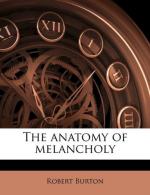Stoechas, fumitory, dodder, herb mercury, roots of capers, genista or broom, pennyroyal and half-boiled cabbage, I find in this catalogue of purgers of black choler, origan, featherfew, ammoniac [4209]salt, saltpetre. But these are very gentle; alyppus, dragon root, centaury, ditany, colutea, which Fuchsius cap. 168 and others take for senna, but most distinguish. Senna is in the middle of violent and gentle purgers downward, hot in the second degree, dry in the first. Brassivola calls it [4210]"a wonderful herb against melancholy, it scours the blood, lightens the spirits, shakes off sorrow, a most profitable medicine,” as [4211] Dodonaeus terms it, invented by the Arabians, and not heard of before. It is taken diverse ways, in powder, infusion, but most commonly in the infusion, with ginger, or some cordial flowers added to correct it. Actuarius commends it sodden in broth, with an old cock, or in whey, which is the common conveyor of all such things as purge black choler; or steeped in wine, which Heurnius accounts sufficient, without any farther correction.
Aloes by most is said to purge choler, but Aurelianus lib. 2. c. 6. de morb. chron. Arculanus cap. 6. in 9. Rhasis Julius Alexandrinus, consil. 185. Scoltz. Crato consil 189. Scoltz. prescribe it to this disease; as good for the stomach and to open the haemorrhoids, out of Mesue, Rhasis, Serapio, Avicenna: Menardus ep. lib. 1. epist. 1. opposeth it, aloes [4212]"doth not open the veins,” or move the haemorrhoids, which Leonhartus Fuchsius paradox. lib. 1. likewise affirms; but Brassivola and Dodonaeus defend Mesue out of their experience; let [4213]Valesius end the controversy.
Lapis armenus and lazuli are much magnified by [4214]Alexander lib. 1. cap. 16. Avicenna, Aetius, and Actuarius, if they be well washed, that the water be no more coloured, fifty times some say. [4215]"That good Alexander” (saith Guianerus) “puts such confidence in this one medicine, that he thought all melancholy passions might be cured by it; and I for my part have oftentimes happily used it, and was never deceived in the operation of it.” The like may be said of lapis lazuli, though it be somewhat weaker than the other. Garcias ab Horto, hist. lib. 1. cap. 65. relates, that the [4216]physicians of the Moors familiarly prescribe it to all melancholy passions, and Matthiolus ep. lib. 3. [4217]brags of that happy success which he still had in the administration of it. Nicholas Meripsa puts it amongst the best remedies, sect. 1. cap. 12. in Antidotis; [4218]"and if this will not serve” (saith Rhasis) “then there remains nothing but lapis armenus and hellebore itself.” Valescus and Jason Pratensis much commend pulvis hali, which is made of it. James Damascen. 2. cap. 12. Hercules de Saxonia, &c., speaks well of it. Crato will not approve this; it and both hellebores, he saith, are no better than poison. Victor Trincavelius, lib. 2. cap. 14, found it in his experience, [4219]"to be very noisome, to trouble the stomach, and hurt their bodies that take it overmuch.”




